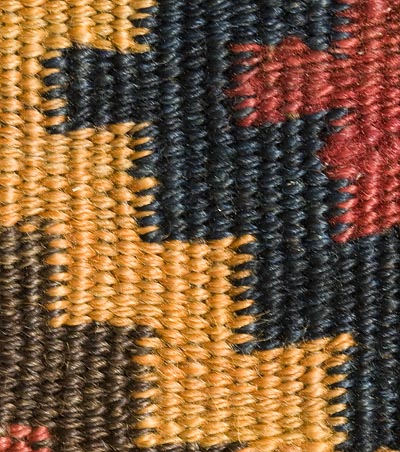Oh, Joel, your piece is so difficult to see
clearly. In some places, one can swear it is dovetailed; in other areas
one can't be sure. A couple of tips: With dovetailing, because twice as
much yarn encircles the common warp between two color areas, a heavier
vertical rib is formed. Sometimes this is clearly visible; sometimes not.
Sometimes you can feel these thicker ribs as you run a finger across the
surface horizontally.
Often a weaving is inconsistent toward the
starting end of a kilim (either type) and as the weaver develops a rhythm
in her work, the piece becomes more consistent and the dovetailing or
interlocking more uniform. Thus it's more practical to examine a piece a
ways into the field. Two weavers may work side-by-side on these kilims, so
the piece may have a slightly different appearance on the left than on the
right. Back and front may also differ; for example, the heavier ribs
created by dovetailing may be more pronounced on one face than the other.
With interlocking, it takes a lot of skill to always place the
point of interlock precisely between the two warps (warps that are jammed
close together anyway), so one time the interlock may get pushed toward
the front surface, another time toward the back. This point of interlock
may be a bit to the left, or a bit to the right, as one yarn is tugged on
a bit harder than the other. Thus it is normal to find inconsistencies in
this weave.
When examining such a piece closely, it can help to
fold it along the weft direction. By rolling it slightly, it should be
possible to pry the yarns apart and see whether two colors alternate in
crossing a single warp.
I'll send a couple photos to Steve which
show a clearer and more precise example of dovetailing--with the same kind
of design of stepped squares as Joel's. This particular piece is
supposedly a Kurdish kilim from the Sauj Bulaq
area.
Marla
Note: Here are the images:

